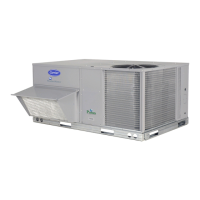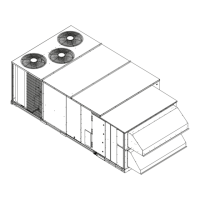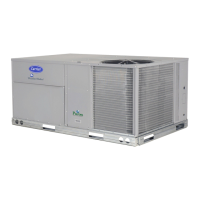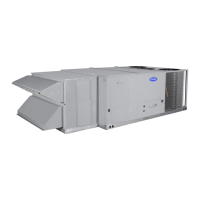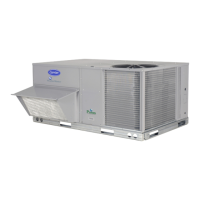13
NOTE: An IAQ switch cannot be used if an enthalpy switch is al-
ready on this input.
IAQ SENSOR
If an CO
2
sensor accessory was field installed, the unit must be
configured for it by setting Configuration
AIR.Q
IA.CF
selects the unit response to this input. Default conversion to 0
to 2000 ppm.
OAQ SENSOR
If an outdoor air quality sensor accessory was field installed,
the unit must be configured for it by setting Configura-
tion
AIR.Q
OA.CF selects the unit response to this input.
Default conversion to 0 to 2000 ppm.
FAN STATUS
If a fan status accessory was field installed, the unit must be
configured for it by setting Configuration
UNIT
FN.SW
to normally open (1) or normally closed (2). Normally open (1)
is the preferred configuration.
FILTER STATUS
If a filter status accessory was field installed, the unit must be
configured for it by setting Configuration
UNIT
FL.SW to
normally open (1) or normally closed (2). Normally open (1) is
the preferred configuration.
Programming Operating Schedules
The ComfortLink controls will accommodate up to eight dif-
ferent schedules (Periods 1 through 8), and each schedule is as-
signed to the desired days of the week. Each schedule includes
an occupied on and off time. As an example, to set an occupied
schedule for 8 AM to 5 PM for Monday through Friday, the
user would set days Monday through Friday to ON for Period
1. Then the user would configure the Period 1 Occupied From
point to 08:00 and the Period 1 Occupied To point to 17:00. To
create a different weekend schedule, the user would use Period
2 and set days Saturday and Sunday to ON with the desired Oc-
cupied On and Off times.
NOTE: By default, the time schedule periods are programmed for
24 hours of occupied operation.
To create a schedule, perform the following procedure:
1. Scroll to the Configuration mode, and select CCN CON-
FIGURATION (CCN). Scroll down to the Schedule Num-
ber (Configuration
CCN
SCH.O=SCH.N). If password
protection has been enabled, the user will be prompted to
enter the password before any new data is accepted. SCH.N
has a range of 0 to 99. The default value is 1. A value of 0 is
always occupied, and the unit will control to its occupied set
points. A value of 1 means the unit will follow a local
schedule, and a value of 65 to 99 means it will follow a
CCN schedule. Schedules 2-64 are not used as the control
only supports one internal/local schedule. If one of the 2-64
schedules is configured, then the control will force the num-
ber back to 1. Make sure the value is set to 1 to use a local
schedule.
2. Enter the Time Clock mode. Scroll down to the LOCAL
TIME SCHEDULE (SCH.L) sub-mode, and press
ENTER. Period 1 (PER.1) will be displayed.
3. Scroll down to the MON.1 point. This point indicates if
schedule 1 applies to Monday. Use the ENTER command
to go into Edit mode, and use the Up or Down key to
change the display to YES or NO. Scroll down through the
rest of the days and apply schedule 1 where desired. The
schedule can also be applied to a holiday.
4. Configure the beginning of the occupied time period for
Period 1 (OCC). Press ENTER to go into Edit mode, and
the first two digits of the 00.00 will start flashing. Use the
Up or Down key to display the correct value for hours, in
24-hour (military) time. Press ENTER and hour value is
saved and the minutes digits will start flashing. Use the
same procedure to display and save the desired minutes
value.
5. Configure the unoccupied time for period 1 (UNC). Press
ENTER to go into Edit mode, and the first two digits of
the 00.00 will start flashing. Use the Up or Down key to
display the correct value for hours, in 24-hour (military)
time. Press ENTER and hour value is saved and the min-
utes digits will start flashing. Use the same procedure to
display and save the desired minutes value.
6. The first schedule is now complete. If a second schedule is
needed, such as for weekends or holidays, scroll down and
repeat the entire procedure for period 2 (PER.2). If addi-
tional schedules are needed, repeat the process for as many
as are needed. Eight schedules are provided. See Table 5
for an example of setting the schedule.
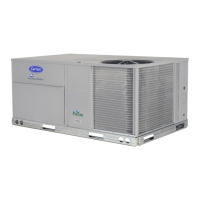
